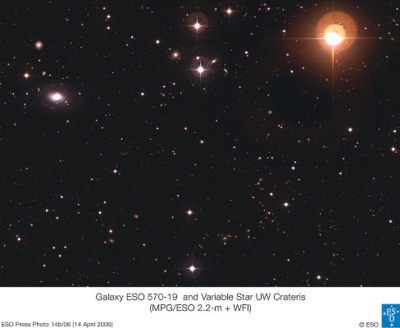The image below is merely a marker — it leads to something far grander. For what you’re looking at is a small part of a vast image of ’empty’ space, made with over 64 hours of observations using the Wide-Field Camera on the 2.2-meter La Silla telescope in Chile. Rather than linking to a simple enlargement of this fragment, I’ve linked instead to a zoomable imaging tool set up by the European Southern Observatory, where you can roam the galaxies in any direction you please in what is called the Deep 3 Field.
Image (click to use the zoom tool): Part of the Deep 3 Deep Public Survey field, showing the brightest galaxy in the field ESO 570-19 (upper left) and the brightest star UW Crateris. This red giant (upper right) is a variable star that is about 8 times fainter than what the unaided eye can see. An ‘S’-shaped ensemble of galaxies is also visible in the lower part of the picture. Credit: European Southern Observatory.
The Deep 3 field is located in what appears to the naked eye as an empty field of space in a southern constellation called the Crater, where the brightest star is of 4th magnitude. The region of sky covered is approximately five times the size of the full moon; within the image are objects 100 million times fainter than what the unaided eye can see. No field is truly empty; this one is actually an open window, taking us back to the most distant regions, and times, of the universe.


